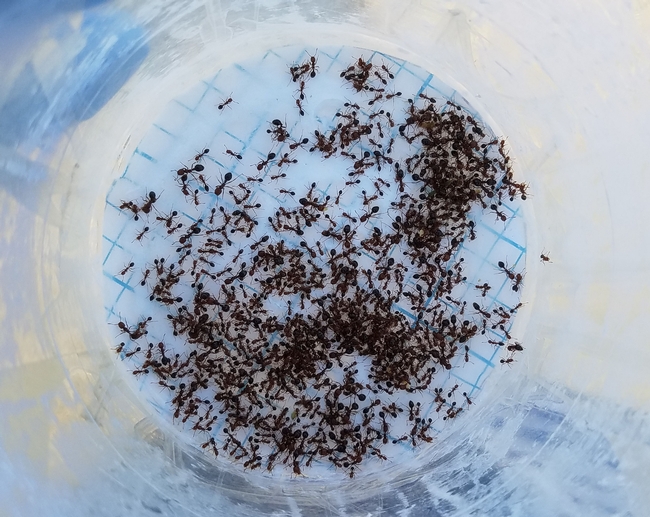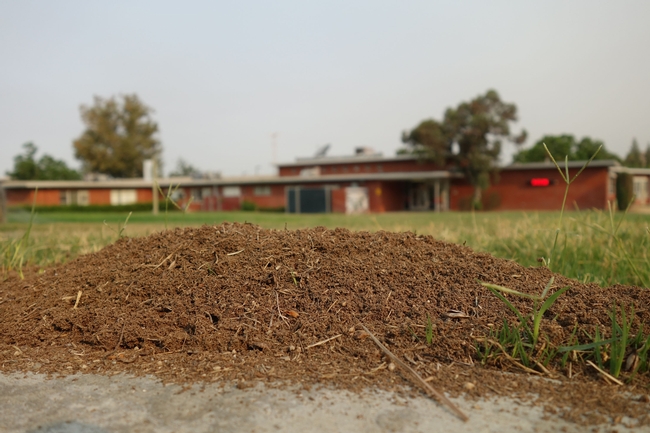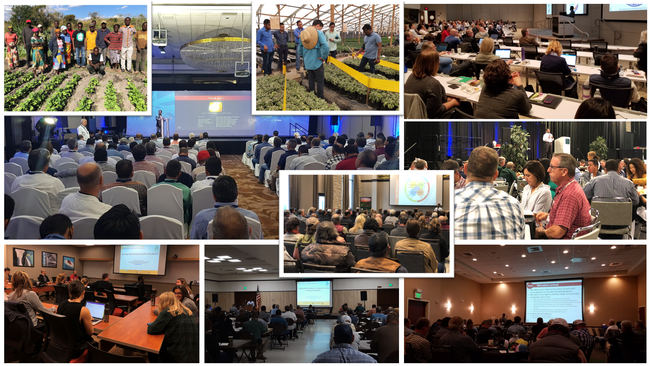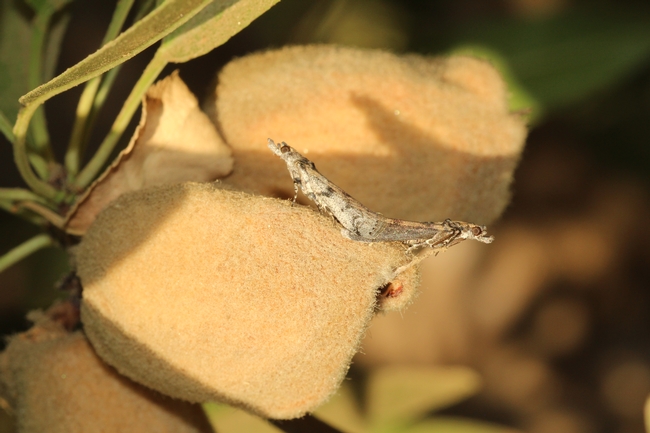- Author: Siavash Taravati
Red imported fire ant (RIFA) control routine guidelines adopted by Los Angeles County school , protecting 500 school students from stings and contributing to improved community health and wellness.
The Issue
Red imported fire ant (RIFA, Solenopsis invicta, Fig. 1) is a venomous ant that was accidentally brought into California in 1989. Since its introduction, it has spread to many new territories in Southern California and Central Valley. RIFA infests lawns on parks, cemeteries, schools, houses, farms, etc. RIFA bites and stings people and its venom may cause anaphylactic shock in susceptible individuals. RIFA is currently found in many areas in Orange, Riverside, and San Bernardino counties. It is also becoming increasingly more problematic in the Merced County. In the Los Angeles County, it occurs near the borderline of Orange and San Bernardino counties. In 2017, the California School for the Deaf in Riverside experienced a severe RIFA infestation and school's ground crew had little success in trying to control RIFA on their 70-acres of land.
How UC Delivers
Dr. Siavash Taravati, an IPM advisor at UC Cooperative Extension office in the Los Angeles County was contacted by the California Department of Pesticide Regulation about this infestation. Taravati visited the school, spoke to the grounds crew on the field, inspected infested areas for RIFA mounds, collected some ant samples for identification, and took some pictures for the study. Later, Taravati created a new pest management program to help the school management reduce the level of RIFA infestations. This study was part of a RIFA management research program and was sponsored by the California department of pesticide regulation. Four different active ingredients were used for suppressing RIFA populations. Granular insecticides were distributed using a handheld spreader or manually by hand. Construction flags and marking spray paint were used to mark areas with RIFA activity. The school was visited by Taravati 2-3 times a month for insecticide applications and monitoring the infestation levels. The project duration was one year. RIFA activity was measured prior to and after treatment. RIFA population declined drastically shortly after the onset of UCCE's RIFA management efforts. After a few months, the number of RIFA mounds in many areas was decreased by 50 percent, and ultimately up to 95 percent in some of the athletic fields that used to be one of the most heavily infested spots. Similar results were obtained in other areas with 90 percent or more reduction in the number of mounds. Even when new mounds appeared periodically on the lawn, they were often small in size. Furthermore, unlike mature and large colony mounds, only a small number of ants emerged from these new mounds when they were poked with a rod.

The Impact
The RIFA control routine guidelines were adopted by the school staff upon finding the best practices from this research. They changed their primary pesticide management method from liquid insecticide applications to using granular baits as much as possible and talked to their supervisors and asked them for more support for their RIFA management efforts. As described above, this research shows that implementing this method decreases RIFA population, thus, protecting 500 school students from stings. Research shows these stings that can cause pain and discomfort and in some cases, life-threatening anaphylactic shock requiring immediate care. In this way, this applied pest management research and extension effort contributed to improved community health and wellness.
Testimonials
School ground crew: I really want to thank you for your great help. It was nice to have help with the fire ants. There aren't many places to get free help for fire ant control. Your work helped us to protect our school kids from being bitten during your reach for sure. We really liked your method of granular bait application and adopted it for better and more efficient fire ant control. Thanks
- Author: Surendra K. Dara
UC ANR Cooperative Extension Advisor Surendra Dara's new IPM model is considered a practical and sustainable approach by educators and practitioners around the world, with an estimated benefit of $33.5 million from improved returns or savings.
The Issue
Integrated pest management (IPM) is a concept of pest management in an ecologically sustainable manner. Although IPM implementation has been promoted for decades and many farms apply IPM practices to some extent there are certain deficiencies in the understanding of IPM and its components and finding non-chemical management options or exploiting cultural practices to improve crop health and yields. The traditional IPM model faces certain challenges because of its limitations for practical applications. There is a need to improve the understanding of growers, pest control advisors, and crop advisors in developing comprehensive crop care strategies using IPM principles, and then there is also a need to revise the traditional IPM model to fit the modern production trends and consumer preferences. The ultimate goal is to improve IPM knowledge and implementation locally, regionally, nationally, and internationally.
How UC Delivers
UC ANR Cooperative Extension Advisor Surendra Dara has been conducting extensive research in providing multiple IPM options such as chemical, botanical, and microbial pesticides for pest and disease management. He also conducts research with biologicals exploring their potential in promoting crop growth and health and their direct or indirect contribution to pest and disease management. Dara recently redefined the IPM paradigm and developed a new model that is economically viable, socially acceptable, and environmentally sustainable. In addition to extending his research information locally and internationally, he has been speaking at various scientific conferences and extension meetings sharing the new IPM model. He has also provided IPM trainings to vegetable farmers in Mozambique and ornamental farmers in Guatemala in 2019, in addition to similar trainings in other countries such as Haiti and Myanmar. Through these efforts, Dara extended the IPM information to professors, researchers, extension professionals, growers, pest control advisors, crop advisors, and others and continues to do IPM education within and outside the United States.
The Impact
An anonymous online survey conducted during one month between early December 2019 and early January 2020 received responses from across California, Hawaii, and several states on the east coast of the US as well as from international respondents representing Argentina, Brazil, Canada, Chile, China, Europe, Indonesia, Kenya, Nigeria, Pakistan, Turkey, Uganda, and other African, Asian, and Central American countries. Out of the 115 responses, 95.7% indicated that they found useful information from Dara's outreach and that they have applied or would apply the information on their farms. Dara's outreach information has been or expected to be applied on nearly 955,000 acres with a $33.5 million improvement in farm income or savings. Another study has shown that the value of UC IPM resources to state-licensed pest control advisors is estimated to by $34 million annually. Survey respondents also indicated that they have further shared the information developed by Dara to over 142,000 of their colleagues, students, clients, or subscribers. Survey respondents included growers, pest control or crop advisors, private researchers, agricultural industry partners, and university faculty or researchers. The new IPM model Dara developed was published in the Journal of Integrated Pest Management in late April 2019 and has been read or downloaded more than 9,200 times so far. This model improves the efficiency of pest management, optimizes the associated costs, and increases the farm profitability. As this model continues to be applied in many farming systems, it increases agriculture efficiency and profitability. In this way UC ANR contributes to the public value of promoting economic prosperity in California.
- Author: David Haviland
- Author: Jhalendra Rijal
- Author: Emily Symmes
As a result of UC ANR's Almond Pest Management Alliance Project, use of mating disruption as an ecologically sustainable pest management practice tripled over two years by growers and pest control advisers who influence over 400,000 acres of almonds in the San Joaquin Valley.
The Issue
Navel orangeworm is the single most important pest of more than 1.3 million acres of almonds in California. It feeds exclusively on almond kernels, rendering them unmarketable. Larvae are also associated with Aspergillus sp. fungi which can produce aflatoxin contamination of kernels at harvest. Control of navel orangeworm is essential to prevent yield losses, off-graded kernels, and kernel contamination.
How UC Delivers
For the past three years, UC ANR Integrated Pest Management (IPM) Advisors David Haviland, Jhalendra Rijal, and Emily Symmes demonstrated an innovative new approach to worm management called mating disruption to more than 16,000 farmers at more than 120 conferences in 36 cities and 20 counties. This technique is done by releasing large quantities of a chemical pheromone used by female moths to attract males. This disorients males and substantially impairs their ability to locate a mate, leading to reduced offspring. Eight demonstration orchards were established across the San Joaquin and Sacramento Valleys as part of an Almond Pest Management Alliance grant in conjunction with the California Department of Pesticide Regulation, almond farmers, pest control advisers, and the Almond Board of California.
The Impact
More than 93% of participants in the Almond Pest Management Alliance Project stated that information that they received was considered when making pest management decisions, with 81.4% reporting that they changed their practices because of what they learned. In the southern San Joaquin Valley, pest control advisers reported increases in the percentage of their acreage using mating disruption from 16.3% in 2017 to 39.0% in 2019 and, in the northern San Joaquin Valley, from 6.5% in 2017 to 37.7% in 2019. These growers and advisers influence over 400,000 acres of almonds.
Mating disruption is agriculturally efficient and profitable because, at harvest, there was a 47.4% reduction in navel orangeworm damage on average across all participating orchards over two years. This increased crop value by more than $250 per acre, which is more than twice the cost of employing this novel management technique.
In addition, the pheremone-based approach is more sustainable because it reduces reliance on pesticides, reducing groundwater contamination and avoiding resistance problems for pests and diseases, respectively. Recent pesticide use reporting data for Kern County underscored these changes in practice, showing a 26% countywide increase in the adoption of mating disruption from 2017-2018 on the more than 200,000 acres bearing almonds in the county.
In this way, UC ANR increases agricultural efficiency, profitability, and ecological sustainability, contributing to the public values of promoting economic prosperity in California and protecting California's natural resources.








